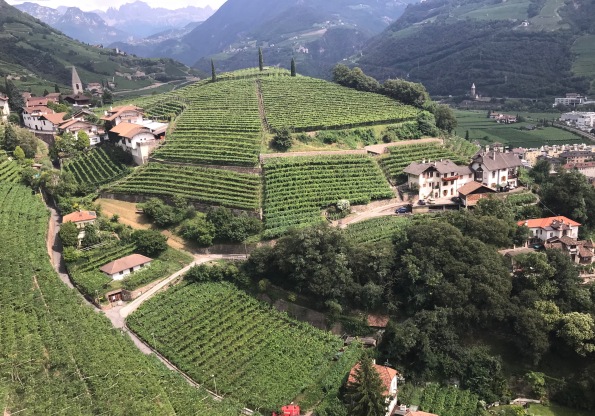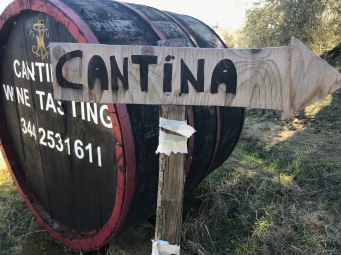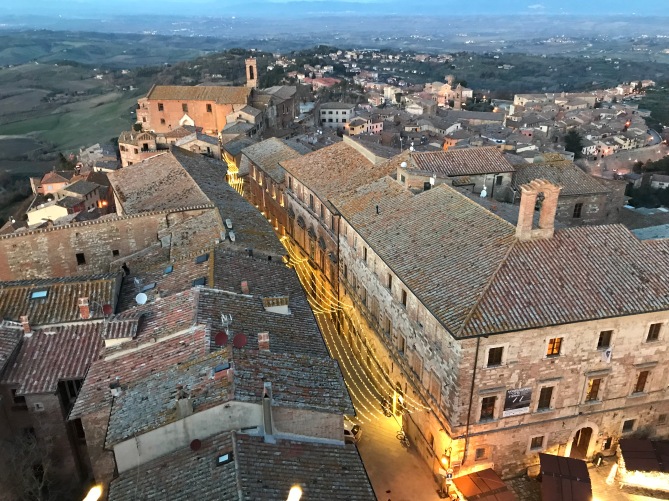Archive
What makes a wine great isn’t a number or a score

Steep hillside vineyards near Bolzano, Italy, illustrate the lengths to which wine makers will go to produce a memorable bottle of wine. Photos and story – Dave Buchanan.
Please indulge me while I share two separate conversations I heard recently.
The first from an acquaintance who recently returned from a late-fall trip to Napa Valley.
He and his wife, both discerning wine people with an appreciation for California-style wines, were visiting friends who introduced our couple to a fairly new but already successful winemaker.
During that initial conversation, the three quickly bonded and soon the winemaker was inviting his new friends to visit his winery, which normally isn’t open to the public. During a late lunch after touring his vineyards and winery, the winemaker graciously opened a couple of bottles from his personal library.
No sales pitch, no pressure, simply a gesture of friendship at our friends’ interest.
The wine, said my friend, “was a Cabernet (Sauvignon) and was simply stunning.”
Not surprisingly, at least to me, our well-funded friends brought a couple of these bottles back home to Colorado.
The second conversation, similar but with its roots 6,000 miles away, began when another acquaintance, this one a wine importer from Denver, remarked how he had met “too many to count” winemakers and their representatives while attending a wine festival in Verona, Italy.
“Almost everyone implored me to visit their winery and hear their story,” this friend recalled. So my friend, an impulsive sort, decided to take advantage of a couple of invitations.
“I saw some amazing estates and some tiny places where one family did all the work,” he said. “And mostly I tasted the same wines there that I tasted in Verona.”
But while sharing lunches and dinners in out-of-way bistros and private homes, he also got an insider’s peek at how Italians view their wines and its role in the everyday life. He gladly paid the extra baggage fees after being gifted a few bottles of Sangiovese-based Vino Nobile di Montepulciano.
Here is where our stories converge.

Nothing says ‘Welcome’ better than a friendly sign outside a neatly run winery.
Both men said that after arriving home, they invited over some friend to share the wines and hear their stories. And both, unknowingly but in similar words, told how the wines showed well but somehow something was missing.
“It’s not that the wines were less than great, they just weren’t that great, not like I remember,” said one.
“Everyone said nice things about the wine and were entertained to hear about how the winemaker’s grandfather had saved his wine from the Germans during World War II by hiding it under the stable,” said the other. “But to me, it just wasn’t the same wine.”
I was fortunate to taste both wines and both were way above what I normally drink. So it probably wasn’t the wines that were lacking. It was, both men affirmed, the experience of being there that made these wines memorable.
Seeing the vineyards, walking through the cellars, listening to the wine as it ages in the barrels, sharing a man’s or a family’s story. This, in great part, is what makes an unforgettable wine. Fortunately, both of these man realize that and neither is in any way disappointed by the wines.
“It’s always expectations versus reality,” one mused. “I know it won’t be the same once I get home but I want so much to share the experience.”
Today, social media (and extra baggage fees) allow us to share, from a distance both special and temporal, some of that experience. Still, it’s but a tantalizing taste of what wines are, what they can be, and what they mean to the people who make them.
The learning curve: one name, two wines

Montepulciano as seen from the bell tower in Piazza Grande.
Remember that oh-so-Tuscan hilltop village featured in the 2004 movie “Under the Tuscan Sun”? Then you’ve seen Montepulciano, Italy.
The village and town date from the Etruscan Period (4th-3rd centuries B.C.) and underwent several rounds of domination until the Florentines finally claimed it in 1511. In 1561, the town became autonomous and today it’s perhaps best known for its wine, Vino Nobile di Montepulciano.
In 1685, poet Francesco Redi named it “the king of all wines” and in 1980 this was among the first Italian wines to receive the strict Denominazione di Origine Controllata e Garantita (DOCG).
Vino Nobile di Montepulciano sometimes is confused with Montepulciano d’Abruzzo, although the latter comes from the province of Abruzzo and is made from the Montepulciano grape (I told you it can be confusing).
Vino Nobile, whose history goes back at least until 789, comes from Tuscany and is by rule at least 70 percent the local Sangiovese clone Prugnolo Gentile.
As Alfonso Cevola recently noted in his blog “On the Wine Trail in Italy,” it’s all part of the “distinct charm of the Italian state of mind to give unlike wines similar names.” And not just wines.
“Anyone who has driven in Italy,” Cevola writes, “and tried to find a town starting with the name of Colle, Castello, Rocca or Monte will recognize the dilemma. But, after all, it’s Italy and people have been finding their way around, eventually, to the town or the Café or the vineyard. Or not.”
Let’s go back to one of the first encompassing Italian wine books most of us read: Italian Wine for Dummies by Mary Ewing-Mulligan and Ed McCarthy. I’ll borrow this quote that Cevola pulls from the book:“The confusion is understandable, but these two wines are definitely different wines made from different grape varieties. Vino Nobile is a dry red wine made primarily from the Prugnolo Gentile variety (a type of Sangiovese) around the town of Montepulciano in southeastern Tuscany. Montepulciano d’Abruzzo is also a dry red wine, but made mainly from the Montepulciano variety, which grows in the region of Abruzzo on the Adriatic coast, southeast of Tuscany. The Montepulciano variety is believed to be native to the Abruzzo region, and it has no connection to Sangiovese or to the town of Montepulciano in Tuscany.”
Which is as clear as it can get, at least when you talk about Italian wines and grape varieties.
In a land of fire and smoke, fine wines are born

The lava flows of Mt. Etna are the background for the rich microclimates in Sicily’s vineyards. Photo courtesy Hotel La Perla
Fire and lava normally aren’t considered attributes for producing elegant wines.
But for Chiara Vigo, who makes unadorned natural wines on her family’s estate, Fattorie Romeo del Castello, in the shadow of Sicily’s Mt. Etna, having an active volcano in her backyard is a way of life.
“For us, it’s a part of our life, something we see every day,” said Chiara during a brief conversation last spring at Vini Veri, a three-day gathering of natural wine makers in Cerea, Italy.
In 1981, when Chiara still was a young girl, well before she went off to earn a Ph.D in art and before she became a wine maker, Etna erupted, spewing ash and smoke and sending rivers of lava down its side.
One lava flow, which Chiara described as tall as a house, approached the estate, which grew grapes, olives and hazelnuts on roughly 60 hectares (about 145 acres) on Etna’s north side.

Chiara Vigo and Gianluca Torrisi show the 2013 Vigo during Vini Veri this spring in Cerea, Italy. Photo by Dave Buchanan
“We thought we would have to leave and lose everything, but when the lava arrived at the part of the old vineyard, it changed direction,” recalled Chiara in a story she’s told countless times.
Instead of engulfing the vineyard, the river of molten rock turned to the east, toward the Alcantra River.
“So now we have a vineyard with a big flow of lava rock inside the vineyard,” she said.
The 1981 eruption wasn’t Etna’s largest or even its most-recent but it does emphasize a certain aspect of danger not usually associated with winemaking, where the prevalent major threats are pests, bad weather and changing markets.
“You see the signs (of the volcano) everywhere,” said Vigo. “But it’s the lava rocks that give us such rich soil and make our wines special.”
That 1981 eruption left her family with 24 hectares (about 57 acres) of Nerello Mascalese vines, some just now starting to produce but also about 14 hectors of 70-100-year old vines in vineyards that reach close to 4,000 feet elevation. Here, under the Romeo del Castello label, she creates what might be called super-organic wines, going beyond the European organic certification and just short of biodynamic: without pesticides or added chemicals and using natural yeasts.
“We try to use the methods of the past traditions of Etna,” she said in the hubbub of La Fabbrica, the vast building in which Vini Veri 2017 was held. “We plant beans in the vineyards to feed the vines.”
This nonintrusive way of adding nitrogen and building the soil now is used by many producers of natural and organic wines.
“And it means instead of using herbicides, we cut the grass” between the rows, she said.
Grapes are hand-harvested and fermented using natural yeasts in open wooden vats.
The wines are aged in oak casks for about 14 months before being bottled without fining or filtration.
“We use only a little sulphur and only when we bottle,” she explained.
She makes two wines, both DOC Etna Rosso: the Vigo made only during the best vintages and the Allegracore, fermented in stainless steel instead of oak.

The 1981 eruption of Mt. Etna left this wall of lave bordering the vineyards of Fattorie Romeo del Castello. Photo – Louie Dressner Selections.
Sicily has more than 2,500 years of winemaking history (Nerello Mascalese has been grown on the Etna slopes for at least 200 years) but production was decimated when phylloxera arrived in the 1930s. While the island once had a reputation as a major producer of bulk wines, over the last 20 years its winemaking has become as complex as anywhere in the world.
Extended harvests (starting in August in the south to extending to mid-November on Etna’s slopes), rich soils and the new fervor of enlightened producers bring an exciting air to this island’s wine futures. In his book “Brunello to Zibibbo,” author Nicholas Belfrage, a British Master of Wine, argued that Sicily has the potential to be “California, Australia, Chile, southern France, Jerez and middle Italy all rolled into one.”
But as someone who lives everyday with the threat of an active volcano looming over her shoulder, Chiara Vigo shrugged at that proclamation.
“It’s true the wines of Etna have changed a great deal in the last 10 or 15 years,” she said. “I make our wines to reconnect with our ancestors and I can’t imagine doing it any way else.”
She pause while opening her 2013 Vigo. “It’s just another way to think, and to see agriculture and to see the earth. It’s our future.”
Her wines are imported by Louie Dressner Selections.
Wine, starting at the ground up

The view across the North Fork Valley is one of diverse terrors, all producing a sense of place in the agriculture and people of the region.
One of the most-revealing ways to visit a winery is to walk its vineyards. This long has been popular as a way to get close to the very land that grows the grapes. You may smell, touch and even taste what it is winemakers are talking about when promoting the importance of terroir, “minerality”, and the like.
The concept of “terroir” can encompass many variants but it has been best served by several writers as the “somewhereness” of a wine, meaning the sum of those factors contributing to a sense of place from which a wine comes.
I’ve spent hours in vineyards with grape growers explaining the differences in soil texture, color and mineral/chemical content and then retiring to tasting rooms where all the strands converge and are revealed in the glass.
If, as it often is, the grape grower and the winemakers are the same person (or work closely together), the message you received in the vineyards is the same message speaking to you from the glass.
However, with the recent discovery of the vine-devastating phylloxera louse in Colorado’s vineyards, the opportunity is gone to walk vineyards (the louse can spread from one vineyard to another by the soil on your shoes) but you still you can look from a distance and, of course, talk to the winemakers about the most-basic of the tools they work with.

Luca Formentini of Podere Selva Capuzza in Brescia, Italy, explains to visitors the importance of the soil to his wines.
While the type and condition of the soil is a common topic of discussion in other winemaking regions, I’ve rarely heard the topic presented in Colorado tasting rooms. Maybe the hosts and hostesses just don’t get asked, or maybe there’s a feeling that the audiences may quickly go glassy-eyed at the very mention of soil chemistry.
And, indeed, some wine critics are skeptical of the concept of terroir or that a vine’s roots can absorb and transfer flavor-enhancing compounds from the soil to the roots.
There’s an interesting article (at least to the stone-suckers among us) about the role of soil to terroir and wine flavors on the wineanorak.com site. The New York Times’ wine critic Eric Asimov recently wrote about the “many variables” that go into “making a wine from a particular place can often be overwhelmed by grape-growing and winemaking decisions.”
This, he argues, loses the “intricacies of terroir” that one finds in wines from, say, Burgundy where that expression “has been raised to a high art.”
He does emphasize, terroir not withstanding, that “the human element” remains uppermost in winemaking. A talented winemaker (the human element) can make good wines no matter where the grapes come from, that’s a given. And that same winemaker learns to use the flavors of the terroir to the wine’s best advantage.
Now let’s return to Colorado wines. I’m often asked (it’s the nature of the job) for my favorite Colorado wine and over the years I’ve discovered there isn’t one, only favorite winemakers.
I’m a firm believer in the role of terroir (I wrote about it here) and this valley and the North Fork Valley have immense ranges of terroir. The Grand Valley has sandy terraces on the west and heavy clay soils on the east, with a few ancient riverbeds, floodplains and long-dry lakebeds thrown in.
The most-obvious example might be in the North Fork, where the Gunnison River divides the landscape into distinct geological regions, volcanic on one side, lots of Mancos Shale across the river, and the wines reflect those differences.
The wines might not taste exactly alike, depending on their origin (part of the terroir). Even grapes from within the same vineyard can taste differently, which is what French winemakers learned centuries ago.
You can test this: Find a winery that makes estate-grown wines and also makes wines from purchased grapes and see if you can distinguish place-of-origin (estate grown) vs. winemaker’s touch theory.
It’s certainly not a bad thing that the human element has a determining role in a wine’s finished product, and you may find it’s not the place or the grape but the winemaker that lifts your spirits.
– Story and photos by Dave Buchanan